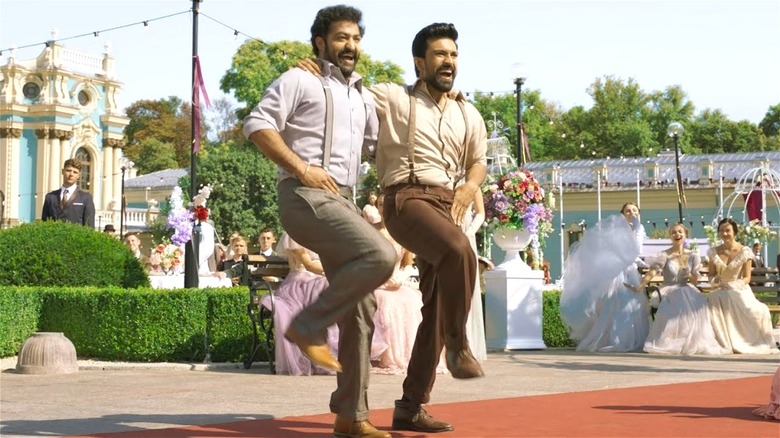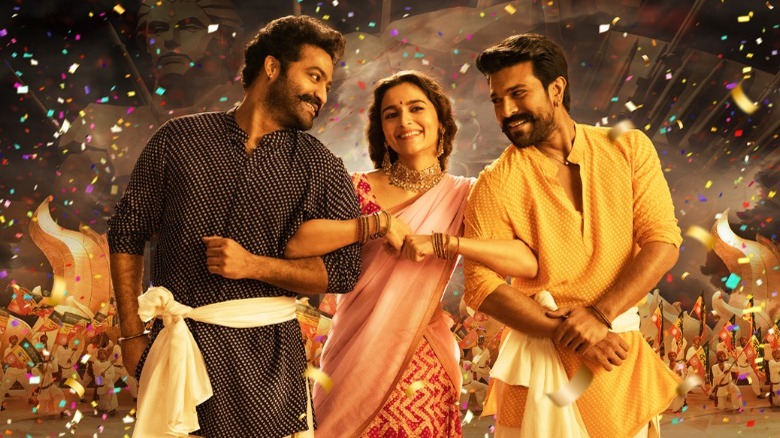Why Dance Is Such A Prominent Part Of RRR Director S. S. Rajamouli's Filmmaking
If you've had the distinct pleasure of watching (or rewatching) S.S. Rajamouli's mind-blowing "RRR," you might agree that the "Naatu Naatu" dance sequence hits different. "RRR" brims with heartfelt spectacle and over-the-top action that works seamlessly with gorgeous visuals, but this particular dance number cements a climactic moment in the arcs of Raju (Ram Charan) and Bheem (N.T. Rama Rao Jr.). I remember watching "RRR" with a packed audience in Delhi, India, and the dance number was met with chaotic, energized hoots and people attempting to perform the "hook-step" from their seats. This kind of theater-wide reaction to "Naatu Naatu" isn't surprising in the least. The song is a certified banger and allows the characters of Raju and Bheem to zestfully further their connected arcs.
Dance numbers are a staple aspect of Tollywood, along with other major language-based film industries in India, including Bollywood and Kollywood. Dance is inextricably woven into the fabric of most Indian cinema, and depending on the genre, these sequences can be quite intense and zestful. As someone who is used to seeing these characters often break into song and dance, the musical enthusiasm of "RRR" obviously did not take me by surprise. However, what did surprise me was Rajamouli's consistent utilization of dance to invite audiences to deeply care about his characters, and how instrumental these sequences are in his filmmaking.
Let's look into how Rajamouli utilizes these musical sequences to invest greater meaning in his stories.
Dance numbers bring people together
Let us talk about "Naatu Naatu" in "RRR" before we dive into how S.S. Rajamouli uses dance to evoke certain emotions in his films. In this case, Raju and Bheem are invited to a British mansion for a party, and this moment acts as a meaningful pause in the film's otherwise breakneck pacing/kinetic action. However, "Naatu Naatu" is not a mere distraction or filler sequence — this is a dance-off that reinstates the film's anti-colonial themes while offering a direct answer to the white men who mock Bheem for his apparent lack of culture moments ago. As the dance-off commences, the beautifully synchronized choreography (by the brilliant Prem Rakshith) allows the two leads to demonstrate cultural flair and a genuine sense of camaraderie.
In an interview with Den of Geek, Rajamouli noted that the wild, enthusiastic tempo and style of "Naatu Naatu" was designed in a way that would even make "the Westerners really root for" Raju and Bheem, despite the context of the scene. The duo's celebration via dance is so vibrant, sincere, and heartfelt that everyone involved in that sequence, no matter what their motivations are, finds themselves momentarily swept into the grandiosity of the moment. Moreover, the combined star power in the scene is dazzling, epitomized during the part where the leads synchronize some sick moves using their suspenders.
Rajamouli went on to explain that dance is "such a strong tool in racking up the audiences' emotions," which is exactly what happens halfway through "RRR." Instead of feeling exhausted, viewers find themselves energized and actively rooting for these two characters having unapologetic fun at a party during the British Raj. A similar effect is achieved during the end-credits song, "Etthara Jenda," which drives the overarching themes of "RRR" home in an exuberant fashion.
Rajamouli uses dance to epitomize emotions
Let's talk about S.S. Rajamouli's epic fantasy film, "Magadheera," which tells a love story that defies time. In this film, Ram Charan plays the dual roles of Harsha and Kala Bhairava, highlighting the cycle of doomed love and reincarnation, which emerges as the central theme of "Magadheera." While Rajamouli weaves a beautiful, tragic, action-laced story with the aid of constant time-jumps and complex character arcs, he uses the song "Dheera Dheera" to heighten the stakes of the central love story. The dynamic between Harsha/Bhairava and Indu/Mithravinda (Kajal Aggarwal) is wonderfully laid out with its nuances and complexities in the course of the dance number, which also acts as an integral part of the plot, in which Bhairava has to formally woo Mithravinda. Instead of abruptly cutting to a musical number for the sake of it, Rajamouli makes sure that these sequences add meaning to his narrative.
A similar technique is used during "Sivuni Aana" in "Baahubali: The Beginning," in which Sivudu's (Prabhas) physical prowess and superhuman strength is underlined with the aid of the song. While this is less of a dance number and more of a character montage, Rajamouli repeatedly uses music to add urgency to a situation or emphasize certain character traits, while urging audiences to emotionally invest in his characters. Rajamouli also manages to accomplish this in "Eega," a film about a reincarnated housefly who enacts revenge on his killer, by incorporating actual buzzing sounds into the soundtrack, as per the level of emotions that needed to be evoked. There's also an extended music video of the CGI housefly belting out some sick moves post-revenge, which you should absolutely check out.


